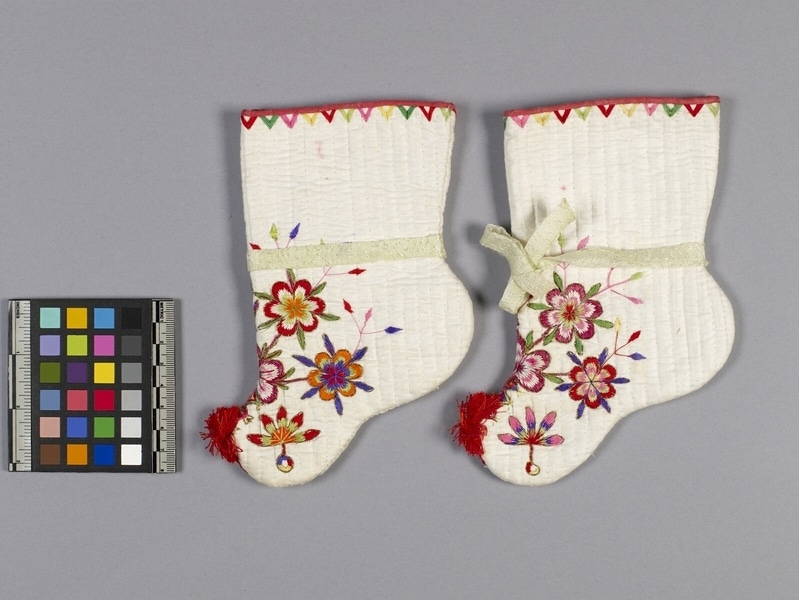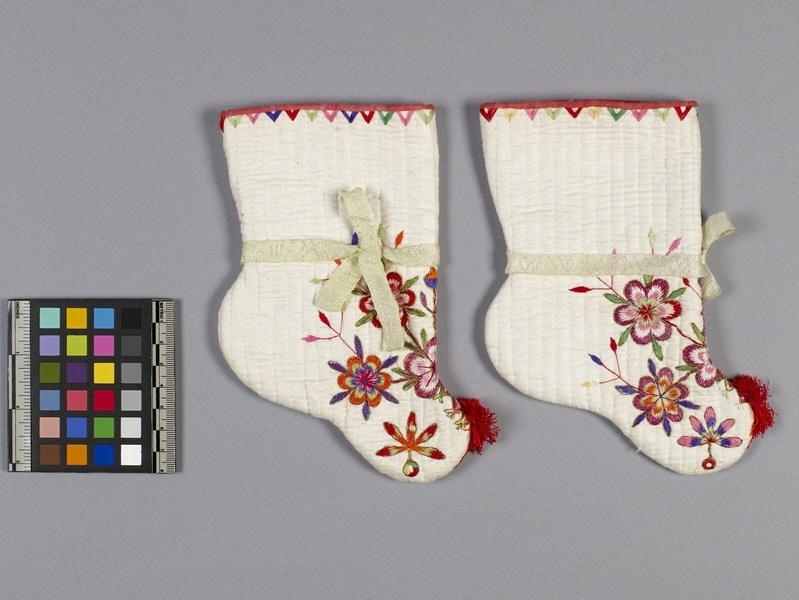Child's Socks Item Number: N3.1 a-b from the MOA: University of British Columbia


Description
A pair of child’s socks made of two quilted sides sewn together with a red cloth border at the top and a red silk tassel on the toe. The socks are made of white cotton cloth, lined with coarser white cotton, and quilted in narrow vertical rows. The rounded heel projects slightly and the arch is slightly indented. Two round flowers and one five-petalled flower are embroidered on each side in multicoloured silk thread outlined in gold, with a third flower over the centre front seam and embroidered v's under the red border. Each sock has a pale green silk ribbon sewed to the back seam above the heel and tied on one side in a single loop bow.
History Of Use
Such decorated socks were worn for a child’s first birthday ceremony, which is very important in Korea. They were originally stitched by the child’s mother. Ribbon ties on the socks for toddlers served to hold them on tightly.
Specific Techniques
Machine-quilted.
Narrative
Collected by J. H. Morris while he was chief engineer for Seoul Railway, Korea.
Iconographic Meaning
The Vs at the top are simplified representations of the shapes of pine cones. The pine represents strong will power and long life. The red tassels and ribbons show that they are for a girl. If they were for a boy, the tassels and ribbons would be blue. The many vertical lines of quilting stitches represent long life, one for each year. Most infants’ clothes have vertical lines for this reason. The embroidered motifs are Japanese apricot tree flowers and buds, which represent purity because of their pure fragrance, harmony, and long life.
Item History
- Made in Korea before 1939
- Collected between 1899 and 1939
- Owned by Marion Stephan before August 1964
- Received from Marion Stephan (Donor) during August 1964
What
- Name
- Child's Socks
- Identification Number
- N3.1 a-b
- Type of Item
- sock
- Material
- cotton fibre, silk fibre, metal and dye
- Manufacturing Technique
- cut, quilted, embroidered and sewn
- Overall
- height 17.8 cm, width 1.6 cm, depth 13.8 cm
Who
- Culture
- Korean
- Previous Owner
- Marion Stephan
- Received from
- Marion Stephan (Donor)
Where
- Holding Institution
- MOA: University of British Columbia
- Made in
- Korea
When
- Creation Date
- before 1939
- Collection Date
- between 1899 and 1939
- Ownership Date
- before August 1964
- Acquisition Date
- during August 1964
Other
- Item Classes
- textiles
- Condition
- good
- Current Location
- Case 77
- Accession Number
- 0113/0066 a-b